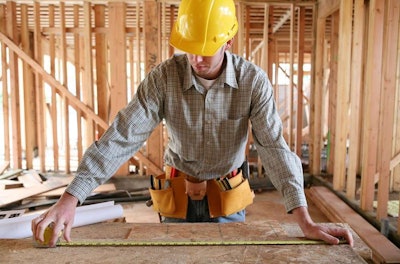
The conference, and the declaration of May as National Building Safety Month, occurred as the Obama administration attempts to encourage builders to formulate and adopt building codes that will result in buildings that better stand up to extreme weather events.
Out of the conference came numerous commitments from government agencies and private sector groups to work toward more resilient codes.
Among notable government agency commitments was the National Institute of Standards and Technology’s pledge to develop state-of-the-science tornado maps that will help designers ensure future buildings are better equipped to withstand high winds and debris.
The U.S. Department of Housing and Urban Development committed to review its existing building construction requirements with the goal of bringing those codes in line with the most recent codes and standards for resilient construction.
The Federal Emergency Management Agency announced it would support the efforts of the National Institute of Building Science in revisiting the 2005 Mitigation Saves study that found every dollar spent on hazard mitigation saved society $4. A new study will attempt to update the 2005 data. FEMA also committed to take a look at incentivizing and adopting building codes at the state and local level through a disaster deductible requirement for the Public Assistance Program.
Notable private sector pledges included Associated General Contractors of America saying it would support a coordinated national strategy to invest in infrastructure while reaching out to construction professionals with education on resiliency initiatives.
The American Institute of Architects meanwhile committed to creating a resilience curriculum for architects.
A list of the remaining commitments is below.
Government agency commitments
- General Services Administration: Climate Change Risk Screening for Capital Investment Leasing Program
GSA commits to systematically incorporate climate change risk management into its Capital Investment Program and the P-100 Facilities Standard. In addition, GSA commits to develop a decision-making framework to help GSA customers identify and manage climate-related risks to their supply chains. These efforts support best value decisions by addressing climate change vulnerabilities and ensuring that the initial public investment is fit for purpose over the asset life.
- U.S. Army Corps of Engineers: Resilient Building Codes Resource Website
Today, the U.S. Army Corps of Engineers launched a website to promote more resilient communities through use of the latest standards and criteria, building codes, and recent climate science. The Corps’ website serves as a single starting point for planners and designers with needs for greater building safety and resilience.
- U.S. Environmental Protection Agency: Smart Growth Code Fixes for Climate Adaptation Report
The U.S. Environmental Protection Agency (EPA) announces the upcoming release of the Office of Sustainable Communities Smart Growth Code Fixes for Climate Adaptation report. This report will give communities a menu of changes they can make to zoning and building codes and related policies to prepare for and adapt to climate change while bringing other environmental, economic, social, and health benefits. The report will be available in Fall 2016.
- Mitigation Framework Leadership Group: Implementation Strategy for Increasing Disaster Resilience Through Federal Support for Building Code Adoption and Enforcement
The Federal interagency Mitigation Framework Leadership Group (MitFLG) announces that the Implementation Strategy for Increasing Disaster Resilience through Federal Support for Building Code Adoption and Enforcement will be released in Fiscal Year 2016. This Strategy identifies several activities Federal departments and agencies can use to align programs, resources, and coordination efforts in the pursuit of increased resilience through building code adoption and enforcement.
- U.S. Department of Homeland Security Office of Infrastructure Protection: Community Infrastructure Resilience Toolkit
The U.S. Department of Homeland Security’s (DHS) Office of Infrastructure Protection announces that it will release the Community Infrastructure Resilience Toolkit (CIRT) in late 2016. The CIRT will help communities develop a Community Infrastructure Resilience Plan that will provide actionable guidance for building critical infrastructure resilience considerations into planning and resource allocation decisions at the community level.
- U.S. Department of Agriculture: Incorporation of Resilient Building Codes into Rural Housing Programs
The U.S. Department of Agriculture (USDA) Rural Development announces it will review its existing building construction requirements with the goal of aligning program requirements with the most recent model building codes and standards for resilient construction. This action responds to the 2014 USDA Climate Change Adaptation Plan recommendations to update building standards to incorporate sustainability and resilience measures.
- U.S. Department of Transportation: Resilient Design of the Volpe National Transportation Systems Center
The U.S. Department of Transportation, in partnership with the General Services Administration, announces that it is seeking an exchange partner to redevelop the 14-acre John A. Volpe National Transportation Systems Center (Volpe Center) in Cambridge, Massachusetts using principles of resilient design on the new Federal building portion of the project.
Private Sector actions
- The Alliance to Save Energy commits to incorporating resilience into existing Alliance building energy code education, development, and implementation efforts.
- The American Society of Interior Designers commits to advancing the awareness of resilient design during its Impact Summit in August of 2016.
- The American Society of Landscape Architects commits to publishing a resilience toolkit that will include research, guides, projects, and other resources to help professionals design resilient landscapes at various scales.
- ASHRAE commits to utilizing member research funding to support research related to resilience in buildings and building systems.
- The Building Owners and Managers Association Internationalcommits to creating webinars focused on existing buildings and code adoption to provide guidance and best practices on how to increase resiliency of buildings.
- In 2016, the Concrete Reinforcing Steel Institute is launching a comprehensive resilience education program incorporating web-based tools and local learning resources to convey best practices for resilient design and construction.
- The Federal Alliance for Safe Homes is launching a new 2016 national hurricane resilience initiative, #HurricaneStrong, through collaboration with FEMA, NOAA/National Weather Service, The Home Depot, and The Weather Channel.
- Florida International University commits to releasing peer-reviewed publications that provide benefit/cost analyses on building code enforcement and effectiveness to inform community decisions to replace, relocate, or retrofit their homes.
- The Green Building Initiative will convene a resilience task force as part of its efforts to update and revise its ANSI/GBI 01-2010 Standard, an assessment protocol for green commercial buildings.
- The Illuminating Engineering Society, through its newly formed Standing Committee on Resilience, will assess lighting’s role in advancing building and community resilience.
- The Insurance Institute for Business & Home Safety is committed to working with FEMA, other Federal agencies, and state and local jurisdictions to increase public awareness and use of FEMA P-804, Wind Retrofit Guide for Residential Buildings.
- The International Association of Fire Chiefs will develop training for the fire and emergency services focused on reducing community risk in order to support a whole community approach to resilience.
- The International Code Council announces that it will co-lead an effort to organize an inclusive, nationwide coalition to create and develop the country’s first Whole-Community metric for resilience.
- The Laborers’ International Union of North America is committed to incorporating the latest knowledge to advance resilience and the implementation of building code provisions through its network of sites offering Department of Labor approved apprenticeship programs.
- The National Association of Mutual Insurance Companiesannounces that it will lead the creation of a national strategy for investing in mitigation.
- The National Concrete Masonry Association commits to developing materials supporting a refined articulation of resilient construction as construction designed and built to survive foreseeable catastrophic events and continue near normal operation within a short recovery period.
- The National Fire Protection Association announces the establishment of a new NFPA technical committee project to develop NFPA 1300 Standard for Community Risk Reduction with an anticipated release in 2017.
- The National Institute of Building Sciences commits to convening key industry stakeholders to develop recommendations to advance resilience and long-term performance in codes, standards, and other policies.
- The Royal Institution of Chartered Surveyors commits to incorporating resilience practices into the RICS Practice Statements with which all RICS members are required to comply.
- The Urban Land Institute announces that in 2016 it will launch a new Returns on Resilience website, which will spotlight design and development leaders in the real estate industry and highlight the business case for resilient buildings.
- The U.S. Green Building Council commits to actively engaging through its partnership in Resilient Communities for America and additional efforts to promote resilient building codes in communities across the country.
- The US Resiliency Council will launch a Building Rating System for Earthquakes in 2016 through which it will advocate for safe buildings and a better public understanding of building performance.
- The Verisk family of companies commits to expanding the Building Code Effectiveness Grading Schedule (BCEGS®) program to aid in a better understanding of the losses avoided and the overall resiliency of a community through the effective enforcement of building codes by developing a new BCEGS grading schedule that will incorporate additional data elements related to resiliency.












